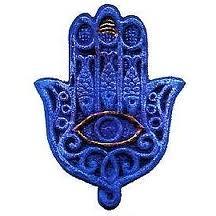The khamsa is a palm-shaped amulet popular throughout the Middle East and North Africa. The khamsa is often incorporated in jewelry and wall hangings, as a superstitious defense against the evil eye. It is believed to originate in ancient practices associated with the Sabaeans and Nabataeans.
Another Arabic name for the hamsa (or khamsa) is the hand of Fatima, commemorating Fatima Zahra, the daughter of the Prophet Muhammad. Today specimens demonstrate that the hand symbolism originates in the world of sexuality. Hamsa hands often contain an eye symbol. Depictions of the hand, the eye, or the number five in Arabic (and Berber) tradition is related to warding off the evil eye, as exemplified in the saying khamsa fi ainek ("five [fingers] in your eye"). Another formula uttered against the evil eye in Arabic is khamsa wa-khamis. Due to its significance in both Arabic and Berber culture, it is one of the national symbols of Algeria, and appears in its emblem.
The khamsa is the most popular of the different amulets to ward off the evil eye in Egypt — others being the Eye, and the Hirz (a silver box containing verses of the Koran). The Hand (Khamsa) has long represented blessings, power and strength and is thus seen as potent in deflecting the evil eye. It's one of the most common components of jewellery in the region.
Archaeological evidence indicates that a downward pointing hamsa used as a protective amulet in the region predates its use by members of the monotheistic faiths. It is thought to have been associated with Tanit, the supreme deity of Carthage (Phoenicia) whose hand (or in some cases vulva) was used to ward off the evil eye.
The hamsa's path into Jewish culture, and its popularity particularly among the Sephardic Jewish community, can be traced through its use in Phoenicia. Jews sometimes call it the hand of Miriam, referencing the sister of the biblical Moses and Aaron. Five (hamesh in Hebrew) represents the five books of the Torah for Jews. It also symbolizes the fifth letter of the Hebrew alphabet, "Het", which represents one of God's holy names. Many Jews believe that the five fingers of the hamsa hand remind its wearer to use their five senses to praise God.


